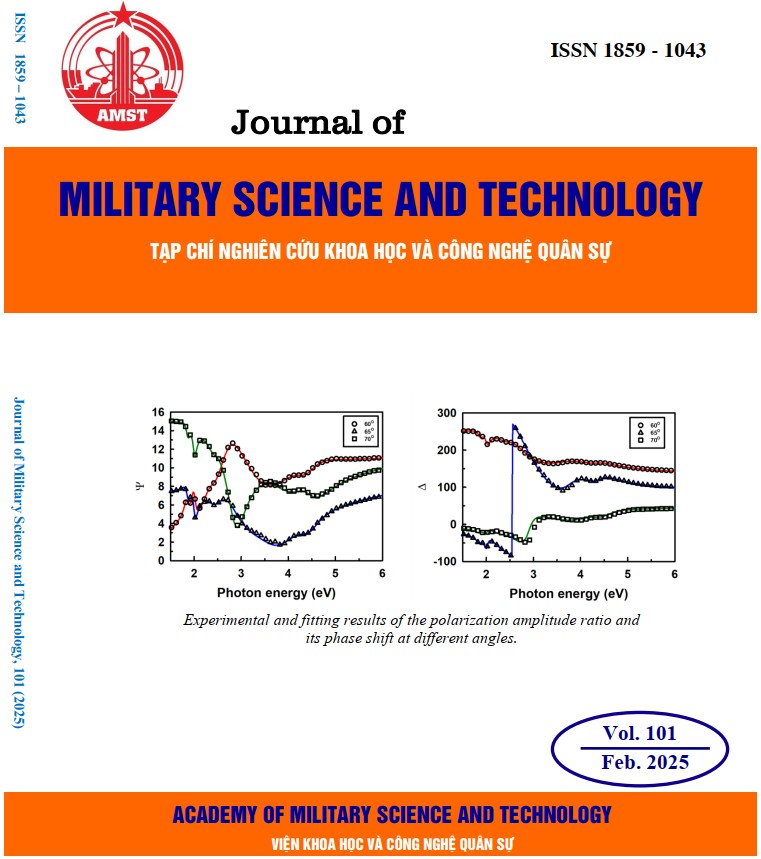Phân hủy methyl orange bằng công nghệ Fenton điện hóa dị thể sử dụng vật liệu xúc tác dạng oxit sắt từ trên chất mang than hoạt tính
368 lượt xemDOI:
https://doi.org/10.54939/1859-1043.j.mst.101.2025.81-87Từ khóa:
Fenton điện hóa dị thể; Methyl orange; Than hoạt tính từ tính.Tóm tắt
Trong nghiên cứu này, methyl orange đã được xử lý bằng phương pháp Fenton điện hóa dị thể với sự có mặt của chất xúc tác Fe3O4/AC và các tấm điện cực với diện tích 100 cm2. Kết quả mang lại hiệu suất loại bỏ methyl orange bằng 98,86 % với các điều kiện tối ưu đã được nghiên cứu bao gồm: pH của dung dịch bằng 3, hiệu điện thế giữa các cặp điện cực bằng 15 V, nồng độ ban đầu của methyl orange bằng 20 ppm và hàm lượng vật liệu được sử dụng là 0,8 g/L. Vật liệu tổng hợp được có khả năng tái sử dụng đạt hiệu suất phân hủy sau 4 lần tái sử dụng bằng 78,5%. Từ đó có thể thấy hiệu quả xử lý ô nhiễm bởi nguồn methyl orange trong nước của phương pháp Fenton điện hóa với chất xúc tác oxit sắt từ trên chất mang than hoạt tính.
Tài liệu tham khảo
[1]. Farhan H.M and Norzahir S, "A review on the water problem associate with organic pollutants derived from phenol, methyl orange, and remazol brilliant blue dyes", Materials Today: Proceedings, Vol 31, pp. A141-A150, (2020), https://doi.org/10.1016/j.matpr.2021.01.258. DOI: https://doi.org/10.1016/j.matpr.2021.01.258
[2]. Kumar D.S, Khairul A.M, Jamil A, Elias M, and Mahiuddin M, "Removal of toxic methyl orange by a cost-free and eco-friendly adsorbent: Mechanism, phytotoxicity, thermodynamics, and kinetics", South African Journal of Chemical Engineering, Vol 40, pp. 195-208, (2022), https://doi.org/10.1016/j.sajce.2022.03.006. DOI: https://doi.org/10.1016/j.sajce.2022.03.006
[3]. Iwuozor K.O, Ighalo J.O, Chizitere E.E, Adewale O.L, and Adaobi I.C, "Adsorption of methyl orange: A review on adsorbent performance", Current Research in Green and Sustainable Chemistry, Vol 4, pp. 100179, (2021), https://doi.org/10.1016/j.crgsc.2021.100179. DOI: https://doi.org/10.1016/j.crgsc.2021.100179
[4]. Sifani Z, Tasneem E, Nourhan I, Mona G, Hyunwoong P, and Dong S.H, "Degradation of organic methyl orange (MO) dye using a photocatalyzed non-ferrous Fenton reaction", Nanomaterials, Vol 13(4), pp. 639, (2023), https://doi.org/10.3390/nano13040639. DOI: https://doi.org/10.3390/nano13040639
[5]. Zhang Z, Wang G, Li W, Zhang L, Chen T, and Ding L, "Degradation of methyl orange through hydroxyl radical generated by optically excited biochar: Performance and mechanism", Colloids and Surfaces A: Physicochemical and Engineering Aspects, Vol 601, pp. 125034, (2020), https://doi.org/10.1016/j.colsurfa.2020.125034. DOI: https://doi.org/10.1016/j.colsurfa.2020.125034
[6]. Abderrazzak A, Ouadrhiri F.E, Kara M, Ibtissam E.M, Amine A, Almutairi M.H, Roula B, Hanan M.R, Ilaria P, and Noureddine E, "Decolorization and degradation of methyl orange azo dye in aqueous solution by the electro fenton process: Application of optimization", Catalysts, Vol 12(6), pp. 665, (2022), https://doi.org/10.3390/catal12060665. DOI: https://doi.org/10.3390/catal12060665
[7]. Tu S, Ning Z, Duan X, Zhao X, and Chang L, "Efficient electrochemical hydrogen peroxide generation using TiO2/rGO catalyst and its application in electro-Fenton degradation of methyl orange", Colloids and Surfaces A: Physicochemical and Engineering Aspects, Vol 651, pp. 129657, (2022), https://doi.org/10.1016/j.colsurfa.2022.129657. DOI: https://doi.org/10.1016/j.colsurfa.2022.129657
[8]. Nguyen V.Linh, Ngo V.T.Huy, Nguyen T.Thuy, Nguyen T.Tung, Tran A.Khoi, and Le A.Kien, "Optimization of 4-chlorophenol decomposition by H2O2 activate catalytic magnetic iron oxide an activated carbon carrier", Journal of Military Science and Technology, Vol 97, pp. 96-104, (2024), https://doi.org/10.54939/1859-1043.j.mst.97.2024.96-104. DOI: https://doi.org/10.54939/1859-1043.j.mst.97.2024.96-104
[9]. Qiang L, Shiming X, Wu X, Wang S, Dongxu J, Wang P, Debing W, and Dong F, "Degrade methyl orange by a reverse electrodialysis reactor coupled with electrochemical direct oxidation and electro-Fenton processes", Electrocatalysis, Vol 13(3), pp. 242-254, (2022), https://doi.org/10.1007/s12678-022-00712-y. DOI: https://doi.org/10.1007/s12678-022-00712-y
[10]. Yakup E, "Nutrition design modeling method development for structural and elemental analysis of bertİz grape pekmez using field emission gun–scanning electron microscope (FEG-SEM)", Kahramanmaraş Sütçü İmam Üniversitesi Mühendislik Bilimleri Dergisi, Vol 26(4), pp. 796-800, (2023), https://doi.org/10.17780/ksujes.1267042. DOI: https://doi.org/10.17780/ksujes.1267042
[11]. Siti F, Risti R, Fitria A.H.D, and Dani A.B, "How to calculate crystallite size from x-ray diffraction (XRD) using Scherrer method", ASEAN Journal of Science and Engineering, Vol 2(1), pp. 65-76, (2022), https://ejournal.kjpupi.id/index.php/ajse/article/view/283.
[12]. Tun H and Chen C, "Isosteric heat of adsorption from thermodynamic Langmuir isotherm", Adsorption, Vol 27(6), pp. 979-989, (2021), https://doi.org/10.1007/s10450-020-00296-3. DOI: https://doi.org/10.1007/s10450-020-00296-3
[13]. Meyerstein D, "Re-examining Fenton and Fenton-like reactions", Nature Reviews Chemistry, Vol 5(9), pp. 595-597, (2021), https://doi.org/10.1038/s41570-021-00310-4. DOI: https://doi.org/10.1038/s41570-021-00310-4
[14]. Zhang S, Meng S, Tayler H, Akshay D, Zhou X, Seunghyun W, Elimelech M, and Kim J.H, "Mechanism of heterogeneous Fenton reaction kinetics enhancement under nanoscale spatial confinement", Environmental Science & Technology, Vol 54(17), pp. 10868-10875, (2020), https://doi.org/10.1021/acs.est.0c02192. DOI: https://doi.org/10.1021/acs.est.0c02192
[15]. Yong L, Yang Z, and Wang J, "Fenton/Fenton-like processes with in-situ production of hydrogen peroxide/hydroxyl radical for degradation of emerging contaminants: Advances and prospects", Journal of Hazardous Materials, Vol 404, pp. 124191, (2021), https://doi.org/10.1016/j.jhazmat.2020.124191. DOI: https://doi.org/10.1016/j.jhazmat.2020.124191
[16]. Yan Q, Zhang J, and Xing M, "Cocatalytic Fenton reaction for pollutant control", Cell Reports Physical Science, Vol 1 (8), (2020), https://www.cell.com/cell-reports-physical-science/fulltext/S2666-3864(20)30153-3. DOI: https://doi.org/10.1016/j.xcrp.2020.100149







